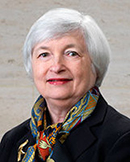The devastating Great Recession of 2008 and 2009 – the worst downturn in the U.S. economy in 75 years – and the distressingly slow recovery that followed were triggered by a severe financial crisis. In response, Congress and federal regulatory agencies revamped and tightened their oversight of the financial system to reduce the odds of a repeat. Former Federal Reserve Chair Janet Yellen, now a distinguished fellow in residence at the Hutchins Center on Fiscal & Monetary Policy at the Brookings Institution, has been watching recent developments in financial regulation with substantial concern. We asked her to elaborate on her concerns, some of which she listed in a lecture at Princeton University in September.
Ten years after the worst of the financial crisis, are we safer?
Yellen: The reforms put in place significantly boosted the resilience of the U.S. financial system. Banks are better capitalized and have more liquidity. The risk of runs owing to maturity transformation has declined. New mechanisms to make it easier for the government to resolve systemically important firms have promoted market discipline and reduced the problem of too big to fail. And a system was devised to more effectively monitor risks that arise outside the regulatory perimeter. But the structure created by Dodd-Frank has shortcomings that create ongoing vulnerabilities, such as a limited toolkit to address emerging risks and insufficient regulatory authority for the Financial Stability Oversight Council (FSOC) and its member agencies to address systemic threats. In addition, although Congress in Dodd-Frank created valuable new powers to resolve a failing nonbank financial firm, it simultaneously scaled back the Fed’s emergency liquidity powers, leaving it with a toolkit that could prove inadequate to cope with a situation like the Crash of ‘08.
When the Obama administration ended, regulatory reform was a work in progress with significant ongoing efforts. In contrast, the Trump Administration has focused on reducing regulatory burden rather than completing unfinished financial stability-related work. After eight years and thousands of pages of rule writing by multiple financial regulatory agencies, it is certainly appropriate to simplify regulations that impose unnecessary burdens, particularly on small community banks. We should also revisit regulations that are overly complex or have unintended consequences. But I’m greatly concerned that the regulatory work needed to address financial stability risk has stalled. There have been some worrisome reversals.
The financial crisis revealed that banks’ capital cushions weren’t nearly large enough to absorb the losses they suffered. As a result, the banks have been required to hold substantially more capital. Do they have enough?
Yellen: The banking system is better capitalized. The quantity and quality of capital required relative to risk-weighted assets have been increased substantially and capital requirements are higher for the largest, most systemic firms. This lowers the risk of distress at such firms and encourages them to limit activities that could threaten financial stability. Among the largest banks, Tier 1 common equity capital has more than doubled since 2009. Importantly, the largest U.S. banks participate in annual stress tests, which are the most important supervisory innovation since the financial crisis. These tests contribute to greater loss-absorbing capacity. The Comprehensive Capital Analysis and Review (CCAR) also improves public understanding of risks at large banking firms, providing a forward-looking examination of firms’ potential losses during severely adverse economic conditions. The stress tests have contributed to significant improvements in risk management at the largest firms.
The stress tests do not yet capture important avenues for the propagation of systemic risk.
That said, there remains an argument—most passionately articulated by Anat Admati at Stanford—that capital requirements should be higher. The imposition of these requirements should reflect a cost-benefit judgment. Higher levels of bank capital mitigate the risk and adverse effects of a financial crisis but raise the cost of intermediation in normal times. Even now, U.S. capital requirements are closer to the lower, not the higher, end of those that could be justified by cost-benefit analysis. In addition, the stress tests do not yet capture important avenues for the propagation of systemic risk. For example, they generally do not directly take account of second-round effects of stress on the financial system, such as the possible fire sale of assets by financial firms in need of capital or funding. Such sales can further depress asset values of other firms below levels resulting from an initial economic or financial shock.
The Fed has the authority to require banks to add to their capital temporarily if it sees a risk that excess credit growth threatens financial stability. This Countercyclical Capital Buffer (CCyB) is now zero. Do you think it should be raised?
Yellen: I would urge the Federal Reserve Board to carefully consider raising the CCyB at this time. Some key financial indicators, such as the ratio of credit to GDP, do not currently signal growing financial stability risk; and the Board’s recent Financial Stability Report assessed vulnerabilities overall as moderate. But I am concerned that asset valuations, including in sectors such as commercial real estate, are elevated and I see dangers relating to the large volume leveraged lending where there’s been a significant weakening of underwriting standards. The high debt burdens of riskier nonfinancial corporations could deepen the next downturn and impose losses on the banking system that would intensify a downturn by restricting the supply of credit. Raising the countercyclical capital buffer now would improve the resilience of the banking system, enabling it to better weather a future downturn. Extra capital can be released when stresses in the economy and the banking system emerge.
Have we licked “too big to fail”?
Yellen: Dodd Frank created a new resolution process for systemically important nonbank financial firms. In 2008, there was no resolution process other than bankruptcy available to resolve the failure of such a firm. That left policymakers with the terrible choice of a destabilizing collapse, as happened with Lehman, or a bailout, as the Fed arranged for AIG and Bear Stearns. Title II of Dodd-Frank provided an alternative resolution mechanism for systemically important firms that can be used instead of bankruptcy proceedings when it is necessary to preserve financial stability. The orderly liquidation authority (OLA) includes a number of tools, including liquidity resources and temporary stays on the termination of financial contracts, that would help protect the financial system and economy from the severe adverse spillovers that could occur if a systemic firm failed. In addition, Congress required the largest banks to submit living wills that describe how they could be resolved under bankruptcy. The Federal Reserve and Federal Deposit Insurance Corp. have worked with banks to ensure that these documents promote real changes in organizational and capital structure and liquidity management that would improve resolvability. Moreover, the Federal Reserve has mandated that systemically important banks meet total loss-absorbing capacity requirements, which require them to maintain long-term debt adequate to absorb losses and recapitalize the firm in resolution. These enhancements in resolvability protect financial stability and help ensure that the shareholders and creditors of failing firms bear losses. These steps promote market discipline, as creditors—knowing that they will bear losses in the event of distress—demand prudent risk-taking, thereby limiting the too-big-to-fail problem.
While the new Orderly Liquidation Authority process provides a valuable resolution method, it will be extremely challenging to carry out in “real time.”
While the new Orderly Liquidation Authority process provides a valuable resolution method, it will be extremely challenging to carry out in “real time.” A firm’s reorganization would typically need to be completed over a “crisis” weekend. Success requires a very high degree of international coordination with a great deal of advance planning among financial authorities here and abroad. Work of this sort received high priority at the Fed and at the Bank of England during the Obama years, but it remains very much a work in progress. Moreover, while it would be challenging, but conceivable, to resolve a single systemic firm hit by an idiosyncratic shock with the new tools that are available, I view the prospects for resolving multiple firms, in a situation characterized by general financial panic—the situation that prevailed in September 2008—as dim. For this reason, I am very concerned that Dodd Frank eliminates the Fed’s legal authority under its 13(3) emergency lending powers to make loans to support an individual systemic institution that would otherwise fail. The law permits the Federal Reserve to implement “broad-based lending programs” to support liquidity in markets—programs like the commercial paper lending facility and the Term Asset-Backed Securities Loan Facility (TALF), that the Fed used successfully in 2009 and 2010 to help the markets meet credit needs of households and small businesses. But loans like those made to support AIG and JP Morgan Chase’s acquisition of Bear Stearns, are now forbidden. Going further, I believe that a strong case can be made for allowing the Fed, on an ongoing basis and not just in a financial crisis, to make its discount window available to broker-dealer subsidiaries of bank holding companies. These entities are now supervised by the Fed and I believe that normal discount window access would diminish the odds of destabilizing runs.
Because so much of the trouble in 2007-09 came from outside the more heavily regulated banks and instead from financial institutions like Bear Stearns, Lehman and AIG, Congress created the Financial Stability Oversight Council (FSOC) and gave it the power to designate institutions that pose a risk to financial stability. How’s that going?
Yellen: In the aftermath of the financial crisis many countries established financial stability committees charged with monitoring and addressing financial stability risk. The U.S. counterpart, the Financial Stability Oversight Council has a similar charge. The most important tool granted by Congress to the Council is the ability to designate nonbank financial institutions that are systemically important for prudential regulation by the Federal Reserve. The purpose of designation is to help guard against the risk that vulnerabilities in firms like AIG that are outside the existing regulatory perimeter grow to levels that jeopardize financial stability. Between 2013 and 2015, the FSOC designated four firms for such supervision: AIG, GE Capital, Prudential Insurance and MetLife. Two of these firms—GE Capital and AIG—chose to radically alter their business models. Those decisions led to substantial reductions in the potential financial system repercussions of their material distress. In recognition of these changes, both firms were subsequently “de-designated” by the FSOC—decisions I supported. The FSOC also recently decided to de-designate Prudential. In contrast, MetLife sued to repeal its designation. In 2016, a district court ruled in its favor, overturning the FSOC’s designation. The Obama Justice Department appealed with the support of the FSOC. The court’s interpretation of Dodd Frank, if accepted, set standards that would make future designations all but impossible. It required that a full-blown cost-benefit analysis and an assessment of the likelihood of the firm’s material financial distress become part of the designation process. Regrettably, the Trump Administration chose to drop the appeal—a decision I strongly opposed – and expressed support for the requirements that, in effect, were imposed by the lower court. That all but eliminates the chances of future designations. A Trump Administration Treasury report on designation argues FSOC should regulate activities, rather than firms that pose systemic risk. I agree that it’s important to regulate activities that heighten systemic risk and, in many cases, this approach makes more sense than regulating firms. But individual firms, such as the pre-crisis AIG, also pose systemic risks. When that’s the case, it is important to supervise and regulate them.
An important change since the financial crisis is that the Federal Reserve now engages in extensive efforts to monitor the entire financial system to detect emerging risks. However, Dodd-Frank envisioned that the FSOC, as an organization, would independently monitor the financial system for emerging risks and it created the Office of Financial Research as an independent unit within Treasury to provide FSOC with its regular assessments. Over the last year, the Trump Administration has substantially cut OFR’s budget and diminished its staffing. Those are regrettable developments that, in my view, highlight the low priority that it attaches to addressing systemic risks.
Fed officials, past and present, often say that interest rates are not the right tool to use to respond to asset prices that rise at an unsustainable pace or to pop a bubble. They say that we should use “macroprudential tools” instead. But do U.S. authorities have adequate macro prudential tools?
Yellen: There are very few macroprudential policy tools in the U.S. to deal with threats that are detected in the monitoring process. One is the countercyclical capital buffer discussed above. However, this applies only to the largest banking organizations in the United States. The stress tests can be viewed as a second macroprudential tool because the scenarios that are incorporated in a particular year can focus on emerging threats. The results both promote adequate capital to guard against the risk in question and provide information about the vulnerability of the most systemic banks. For example, tests in recent years have focused on the risks from elevated commercial real estate prices. However, many countries have armed their financial stability committees with macroprudential tools in mortgage lending that U.S. regulators lack such as minimum loan to value ratios, debt-to income ratios and affordability criteria . Housing is often at the center of financial crises in advanced economies and recessions caused by housing busts tend to be more severe than other downturns. Countries that fear the consequences of an emerging housing bubble use such tools to limit credit growth and the rate of house price appreciation. No such tools are available in the United States.
Are you concerned by what’s happening in corporate lending today?
Yellen: Corporate indebtedness is now quite high and I think it’s a danger that if there’s something else that causes a downturn, that high levels of corporate leverage could prolong the downturn and lead to lots of bankruptcies in the non-financial corporate sector. There has been a huge deterioration in corporate lending standards, particularly in the $1.3 trillion market for leveraged loans (a loan to a company that already has a lot of debt or is otherwise risky, usually sold by the originator to someone else.) I’m worried about the systemic risks associated with these loans. I think a lot of the underwriting of that debt is weak.
Bank supervisors have noted egregious underwriting deficiencies, weakening covenants and escalating credit risks. Because many such loans are securitized or sold into the market, they pose limited risk to the safety and soundness of individual financial institutions. However, these loans may pose risks to financial stability similar to those associated with securitized subprime mortgages a decade ago. Losses, in the event of bankruptcies, are likely to exceed those experienced historically. The banking agencies issued guidelines in 2013 that were intended to improve underwriting standards and address increased credit risks. Over the last few years, however, Congress and the industry have pushed back against these standards. Recently, Joseph Otting, Trump’s Comptroller of the Currency, indicated that he would allow such loans as long as the originating bank has adequate capital to bear losses—a perspective that is “micro” and not “macroprudential.” Following this comment, the degree of leverage in new lending has reportedly shot up. In addition, the DC circuit court recently ruled that packagers of these loans do not need to meet the “skin in the game” requirements that were mandated by Dodd-Frank. The entities that hold leveraged loans appear to be largely unlevered institutions and individuals, which limits the financial stability risk posed by this lending. Nevertheless, developments in this area are reminiscent of the pre-crisis pushback that occurred against any meaningful supervisory restrictions on risky commercial real estate lending particularly for land and construction development—lending that fueled the subprime housing boom.






Commentary
Seven questions for Janet Yellen on financial stability
January 3, 2019